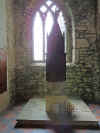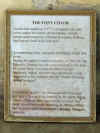 Location:
Amongst the gravestones,
about 10 yards to the east of the path leading up to the south door to the
church. Location:
Amongst the gravestones,
about 10 yards to the east of the path leading up to the south door to the
church.O/S Grid Ref:
SX/54288/63104
Longitude/Latitude (Degrees+/-): -4.05376/50.44963
Map location:
Click here
to view map.
Purpose: Socket
stone for a churchyard cross.
Size: The
socket stone measures 3 feet 1 inch (0.94 metres) in diameter and at least
7˝ inches (0.19 metres) deep. The socket is 13˝ inches (0.34 metres)
long, by 12 inches (0.31 metres) wide and 5˝ inches (0.14 metres) deep.
Information:
This socket stone is set
into the ground and is laying flat between two gravestones. It has been
well-worked into an octagonal shape and is in very good condition all
round. As the socket does not go all the way through the stone, it is
prone to filling up with rainwater.
 At the steps
leading up to the east gate of the church, there is a long shaped stone
lying on top of the roadside wall, acting as a coping stone. It is quite
possible that this is the shaft of the cross that once stood in the above
socket stone as the Churchyard Cross. The stone measures 4 feet 5 inches
(1.35 metres) long by 9 inches (0.23 metres) wide and 8 inches (0.20
metres) deep. The top end of the stone is square and would have been the
base of the cross. The main length of the stone is chamfered on all four
edges and it has been broken off at the point that would have been
immediately under the arms of the cross. There is no sign of the
whereabouts of the head and arms of this cross. There is a hole in the top
face of the stone, near the upper end, which is irregular in shape and is
now filled with cement. There is also a shallow slot on the inside edge
towards the bottom of the stone. At the steps
leading up to the east gate of the church, there is a long shaped stone
lying on top of the roadside wall, acting as a coping stone. It is quite
possible that this is the shaft of the cross that once stood in the above
socket stone as the Churchyard Cross. The stone measures 4 feet 5 inches
(1.35 metres) long by 9 inches (0.23 metres) wide and 8 inches (0.20
metres) deep. The top end of the stone is square and would have been the
base of the cross. The main length of the stone is chamfered on all four
edges and it has been broken off at the point that would have been
immediately under the arms of the cross. There is no sign of the
whereabouts of the head and arms of this cross. There is a hole in the top
face of the stone, near the upper end, which is irregular in shape and is
now filled with cement. There is also a shallow slot on the inside edge
towards the bottom of the stone.
The original Shaugh
Prior Church was built in the 12th century. However, this must
have been demolished at some point as the current church dates from the
mid-15th century. The church is dedicated to St Edward, who was
crowned King of England in 975, at the tender age of 14 years. Edward the
Martyr, as he became known, succeeded his father, Edgar the peaceful. His
was a short reign as he was murdered at the instigation of his stepmother,
Elfrida, in 978. It, perhaps, comes as no surprise the he was, himself,
succeeded by his half-brother Ethelred the Unready, son of King Edgar and
Elfrida. St Edward’s feast day is celebrated on March 18th.
  One point of great interest inside the church is the magnificent font
cover. It is made of solid oak, octagonal in shape and is about 8 to 9 feet
tall. Its height is in three stages; The first two are perpendicular and
the upper one is a spiral. It is topped off with the figure of a mitred
bishop, in full robes giving a blessing. The font cover was removed during
the restoration of the church in 1868-69 and temporarily placed in the loft
of a neighbouring farmhouse for safekeeping. It wasn’t until 1878 that
the Prebendary Bartholomew realised that it had not been reclaimed and
replaced in the church. The then vicar, the Rev. J.B. Strother, made
enquires and managed to locate it. However, it was found to be badly
damaged but repairs were made and it was eventually restored to its
rightful place in the church. At the time of my recent visit (2021)
there was a framed sheet of printed notes resting against the font setting
out the history of the font cover, a photo of which is shown to the right
of these notes. One point of great interest inside the church is the magnificent font
cover. It is made of solid oak, octagonal in shape and is about 8 to 9 feet
tall. Its height is in three stages; The first two are perpendicular and
the upper one is a spiral. It is topped off with the figure of a mitred
bishop, in full robes giving a blessing. The font cover was removed during
the restoration of the church in 1868-69 and temporarily placed in the loft
of a neighbouring farmhouse for safekeeping. It wasn’t until 1878 that
the Prebendary Bartholomew realised that it had not been reclaimed and
replaced in the church. The then vicar, the Rev. J.B. Strother, made
enquires and managed to locate it. However, it was found to be badly
damaged but repairs were made and it was eventually restored to its
rightful place in the church. At the time of my recent visit (2021)
there was a framed sheet of printed notes resting against the font setting
out the history of the font cover, a photo of which is shown to the right
of these notes.
In addition to this
cross parts, Shaugh
Prior also has a village cross, a modern man-made
cross (on the same page as the village cross) and a War
Memorial Cross, which is also inside the churchyard.
|


 Location:
Amongst the gravestones,
about 10 yards to the east of the path leading up to the south door to the
church.
Location:
Amongst the gravestones,
about 10 yards to the east of the path leading up to the south door to the
church.